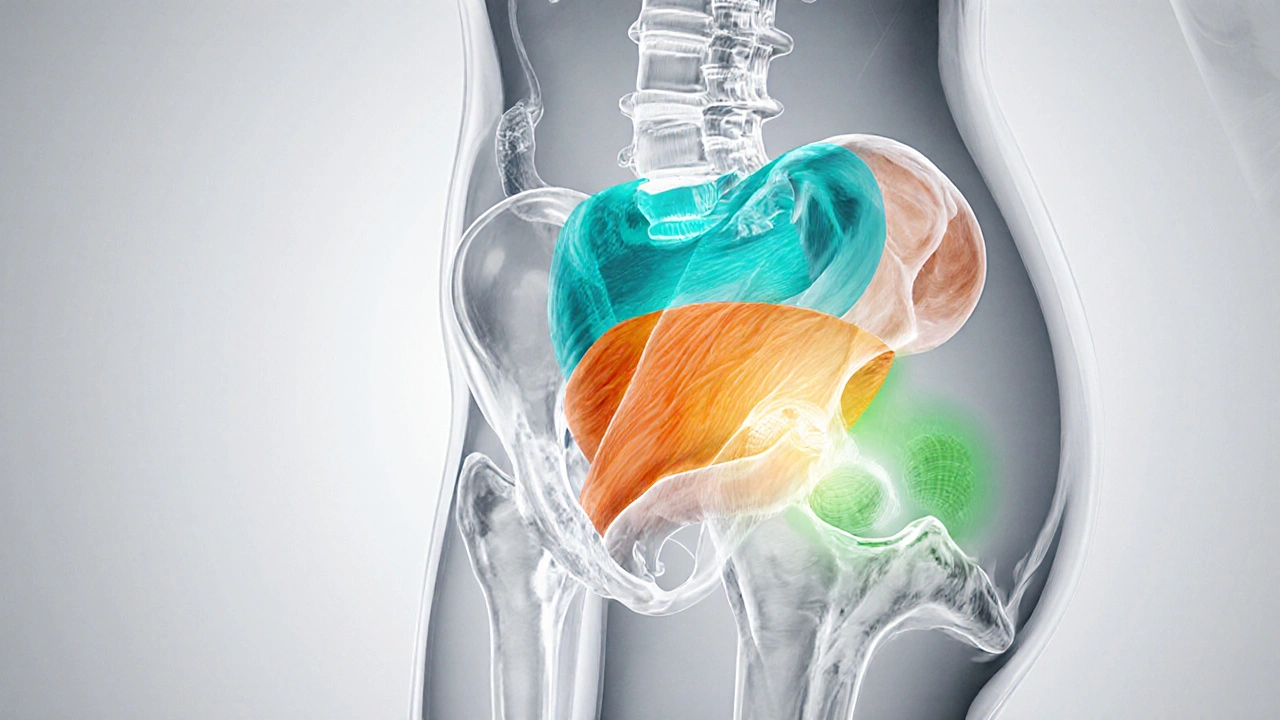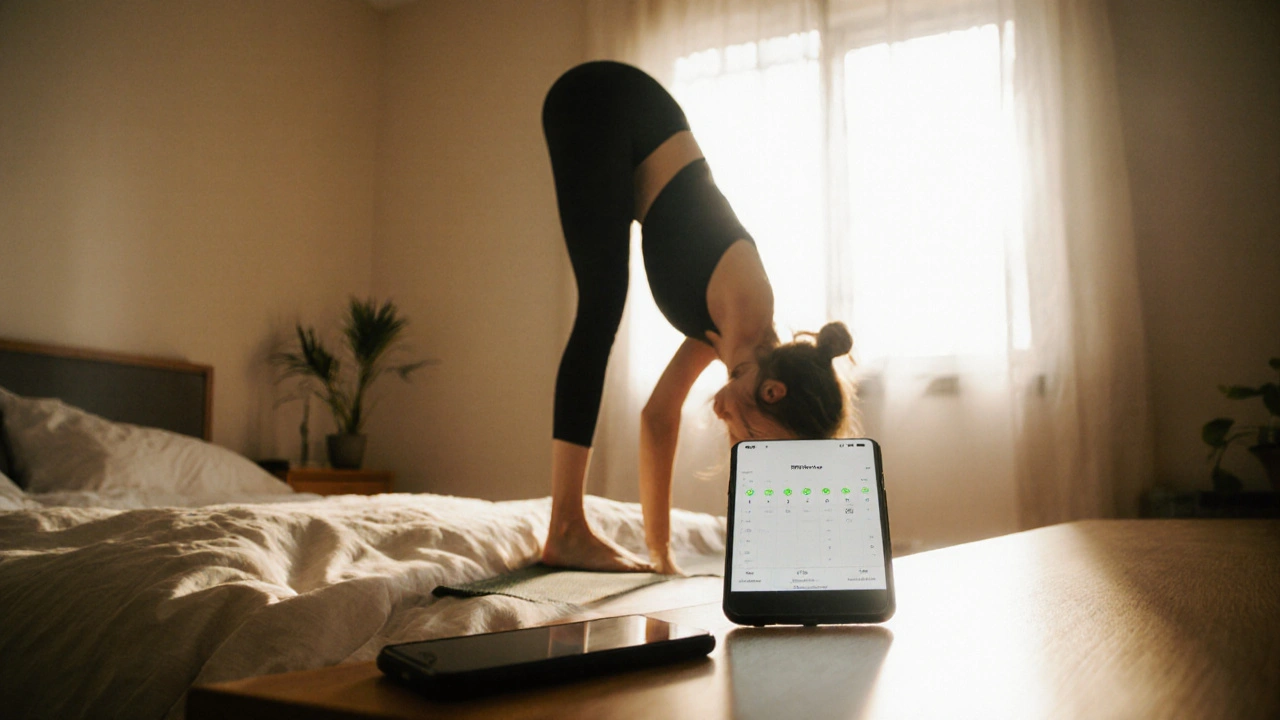Pelvic Floor Exercise Tracker
Kegel Exercises
Slow, sustained contractions of the pelvic floor muscles. Hold for 8-10 seconds.
Quick Flicks
Rapid, short squeezes to recruit fast-twitch fibers. Squeeze for 1-2 seconds.
Bridge Lifts
Hip-raising movement that also engages the pelvic floor. Lift hips off ground.
Spasm Intensity
Rate your current urinary spasm intensity (0 = none, 10 = severe).
Kegels
0/100 reps completed
Quick Flicks
0/100 reps completed
Bridge Lifts
0/50 reps completed
Remember to practice pelvic floor exercises consistently. Even just 5 minutes a day can make a significant difference in managing urinary spasms.
When the bladder starts sending sudden, uncomfortable jerks, you might think medication is the only answer. In many cases, the real fix is a set of targeted movements that many people overlook. Pelvic floor exercises are a group of low‑impact movements designed to strengthen the muscles that support the bladder, bowel, and reproductive organs can calm urinary tract spasms involuntary contractions of the bladder wall that cause sudden urges, leakage, or pelvic pain without a prescription. The real power lies in pelvic floor exercises that target the right muscles at the right intensity, giving you control back in minutes a day.
Understanding Urinary Tract Spasms
First, let’s break down what’s happening inside the body. The detrusor muscle is the smooth muscle that lines the bladder wall and contracts to push urine out can become over‑active for several reasons: hormonal shifts, chronic infections, or even stress. When it fires off too often, you feel the infamous “spasm” - a sudden, sharp urge to empty the bladder that may or may not end in leakage.
These spasms are not just a nuisance; they can disrupt sleep, limit social activities, and lower confidence. While doctors may prescribe anticholinergics or bladder‑training programs, research from the American Physical Therapy Association (2023) shows that strengthening the surrounding support system often normalizes detrusor activity, reducing the frequency and intensity of spasms.
Meet the Pelvic Floor Muscles
The pelvic floor muscles form a hammock‑like sling from the pubic bone to the tailbone, supporting the bladder, uterus, and rectum act like a built‑in brace for the bladder. When they’re weak or uncoordinated, the detrusor muscle works harder, leading to spasms. Strengthening these muscles improves bladder control the ability to start and stop urine flow at will, reducing urgency and leakage and can even enhance sexual satisfaction by increasing pelvic stability.
Think of the pelvic floor as the core of your lower body. Just as a solid core stabilizes the spine during a plank, a strong pelvic floor stabilizes the bladder during daily activities like lifting, coughing, or laughing.
The Core Benefits of Targeted Exercise
- Reduced frequency of spasms: Regular training re‑educates the nervous system, lowering involuntary detrusor contractions.
- Improved urgency management: Stronger muscles give you a longer window to reach the bathroom.
- Lower risk of urinary incontinence: By supporting the urethra, the pelvic floor helps keep urine locked until you decide to let it go.
- Enhanced core stability: A tight pelvic floor contributes to better posture and lower‑back health.
- Potential sexual health boost: Many people report stronger orgasms and reduced pain during intercourse.
Key Exercise Types and How to Perform Them
Below is a quick reference of the most effective movements. Each targets a slightly different muscle fiber, ensuring a balanced program.
| Exercise | Target Muscle | Typical Reps | Suggested Frequency |
|---|---|---|---|
| Kegel exercises slow, sustained contractions of the pelvic floor | Deep fibers (levator ani) | 8‑10 seconds hold, 10‑15 reps | 3‑4 times daily |
| Quick flicks rapid, short squeezes to recruit fast‑twitch fibers | Superficial fibers | 5‑second squeeze, 20‑30 reps | 2‑3 times daily |
| Bridge lifts hip‑raising movement that also engages the pelvic floor | Posterior chain + pelvic floor | 10‑12 lifts | Every other day |
Here’s how to nail a basic Kegel:
- Find the right muscles by stopping the flow of urine mid‑stream (do this only for practice, not habitually).
- Take a slow, deep breath, then gently squeeze the pelvic floor as if you’re holding back gas.
- Hold the contraction for 8‑10 seconds while continuing to breathe normally.
- Release slowly, feeling the muscles relax completely for at least 10 seconds.
- Repeat for the prescribed number of reps.
Quick flicks follow the same muscle‑finding step, but you contract and release within 1-2 seconds. The rapid rhythm trains fast‑twitch fibers that are crucial for stopping a sudden spasm.
Bridge lifts add a functional element: lie on your back with knees bent, press through your heels to lift hips, and at the top, give your pelvic floor a gentle squeeze. This not only works the floor but teaches you to engage it during everyday movements.

When to Seek Professional Guidance
If you’ve tried basic routines for a few weeks and still feel frequent spasms, it might be time for pelvic floor physical therapy a specialized form of physiotherapy that uses biofeedback, manual techniques, and tailored exercise plans. A trained therapist can assess muscle tone with an internal exam, teach you precise activation patterns, and provide tools like vaginal or anal cones for progressive loading.
Look for a therapist certified by the American Physical Therapy Association’s Women’s Health Section. Many clinics now offer telehealth sessions that let you demonstrate technique via video, making follow‑up easy.
Common Pitfalls and How to Avoid Them
- Holding your breath: Breathing should stay relaxed; clamping down reduces oxygen flow and can cause tension elsewhere.
- Using the wrong muscles: Squeezing the glutes or thighs won’t help. Use the “stop pee” test to confirm you’re targeting the correct area.
- Over‑doing it: Muscles need recovery. Start with low volume and gradually increase; soreness that lasts more than a day suggests you’re pushing too hard.
- Inconsistent practice: Benefits appear after 4‑6 weeks of regular work. Put the routine on your phone reminder or link it to a daily habit like brushing teeth.
Tracking Progress and Setting Realistic Goals
Keep a simple log: note the date, type of exercise, reps, and any noticeable change in urgency or leakage. Use a 0‑10 scale for spasm intensity; a drop of 2 points over a month usually signals meaningful improvement.
Goal example: “Reduce nightly bathroom trips from three to one within six weeks.” Review the log weekly and adjust reps or frequency if progress stalls.
FAQs - Quick Answers to Common Questions
Frequently Asked Questions
Can men benefit from pelvic floor exercises for urinary spasms?
Absolutely. Men experience overactive bladder and prostatitis‑related spasms, and a strong pelvic floor helps control the urethral sphincter. The same Kegel and quick‑flick routines apply, just with a slightly different muscle‑finding cue (stopping gas flow).
How long before I notice a change?
Most people report a reduction in urgency within 3‑4 weeks of consistent practice. Full spasm control can take 6‑8 weeks, depending on baseline muscle tone and frequency of training.
Is it safe to do these exercises during pregnancy?
Yes, and often recommended. Strengthening the pelvic floor before delivery can reduce postpartum incontinence. However, avoid holding breath and stop if you feel pelvic pain; consult a prenatal physiotherapist for tailored guidance.
Do I need any special equipment?
No equipment is needed for basic Kegels or quick flicks. A yoga mat makes bridge lifts comfortable, and biofeedback cones can add progressive resistance once you’re comfortable with the basics.
What if I have chronic prostatitis or interstitial cystitis?
Pelvic floor training is still beneficial, but you’ll want a clinician experienced with those conditions. Gentle, low‑intensity contractions are preferred initially to avoid aggravating pain.

Take the First Step Today
Start with just five minutes-three Kegels, ten quick flicks, and two bridge lifts-while you’re watching TV or scrolling your phone. Consistency beats intensity, and within a month you’ll likely notice fewer urgent trips and a calmer bladder. Remember, the pelvic floor is your body’s built‑in support system; treating it like a muscle instead of a mystery can change how you live day to day.


steve wowiling
October 5, 2025 AT 02:50Wow, who knew the pelvic floor could be the unsung hero of bedtime drama?
Warren Workman
October 5, 2025 AT 02:53While the lay‑person narrative glorifies "quick fixes," the underlying neurophysiology suggests that indiscriminate contraction protocols may inadvertently exacerbate detrusor hyperactivity; thus, a rigorous, evidence‑based protocol is indispensable.
Kate Babasa
October 5, 2025 AT 02:56Indeed, the mechanistic synergy between levator ani activation and urethral closure pressure is, frankly, a cornerstone of continence; however, one must also consider the psychogenic overlay-stress, anxiety, and even social stigma can modulate spinal reflexes, thereby influencing spasm frequency; consequently, a biopsychosocial approach is warranted.
king singh
October 5, 2025 AT 03:00Consistent practice, even at modest volume, tends to yield measurable improvements in urgency control.
Adam Martin
October 5, 2025 AT 03:03I get it, the internet loves to hype up the idea that a few minutes of squeezing will magically transform your bladder into a zen garden. But let’s be real: the pelvic floor is just another skeletal‑muscle system that follows the same overload‑principle as any other workout. If you neglect progressive overload, you’ll stay stuck at the same baseline and wonder why the “spasms” persist. The science behind it, as outlined by the American Physical Therapy Association, actually emphasizes consistent, incremental load rather than celebrity‑style hype. Start with a solid mind‑muscle connection-find the correct muscles by stopping gas, not urine, to avoid the classic ‘stop‑the‑stream’ trap. Then, schedule three to four sets of slow Kegels, each holding for eight to ten seconds, before moving on to quick flicks for fast‑twitch recruitment. Bridge lifts are not just a glute thing; they teach you to co‑activate the floor during functional movements like lifting a suitcase. Track your reps in a simple spreadsheet or an app, note the spasm intensity on a 0‑10 scale, and look for a two‑point drop over a month as a realistic benchmark. If you’re not seeing any decrement after six weeks, consider a qualified pelvic‑floor physical therapist who can provide biofeedback and manual techniques. Don’t ignore breathing; holding your breath turns the exercise into a Valsalva maneuver, which can actually aggravate the detrusor muscle. Remember, consistency beats intensity-five minutes a day for a month beats an hour once a week and then never again. Also, avoid the myth that you need fancy cones right out of the gate; a yoga mat and a timer are sufficient for beginners. If you’re dealing with chronic prostatitis or interstitial cystitis, tone down the fast‑twitch work and focus on gentle, low‑load contractions. And yes, you can still have a social life; just set a reminder on your phone, maybe after brushing your teeth, to cue the routine. In the end, the pelvic floor isn’t a mystical cure‑all; it’s a lever you can train to take some pressure off an over‑active bladder. So keep the drama low, the reps steady, and let the data speak for itself.
Ryan Torres
October 5, 2025 AT 03:06Sure, the "data" says it works, but have you considered that the pharma giants are quietly pushing these exercises to divert attention from their hidden bladder‑control drugs? 🤔💊 Keep your eyes open.
Marcia Bailey
October 5, 2025 AT 03:10Great point on the need for progressive overload, Warren. For anyone just starting out, I recommend logging each set in a simple notebook or app, focusing on form first, then gradually increasing hold time by 2‑3 seconds each week. Consistency is key, and remember to breathe normally throughout each contraction.
Hannah Tran
October 5, 2025 AT 03:13Kate, your comprehensive breakdown is spot‑on. One extra tip: during bridge lifts, imagine gently pulling the pelvic floor upward as you raise your hips-this cue helps synchronize core and floor activation, especially for beginners who tend to over‑activate glutes alone.
Crystle Imrie
October 5, 2025 AT 03:16Really? Another "miracle" post-let’s not pretend this replaces proper medical care.
Shelby Rock
October 5, 2025 AT 03:20i guess if you keepin up with them pelvicl floor thingz u might just chill a lil, but dont expect no magic.